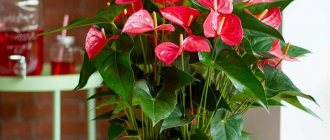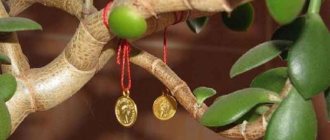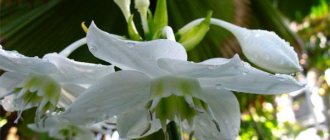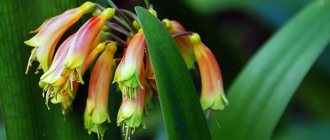Under natural conditions, this plant grows in Malaysia; it can also be seen in the eastern part of India.
In nature, there are 17 varieties of such crops, the height of individual specimens reaches 2.5 meters.
General information
The codiaum flower feels good when grown indoors. This plant has many varieties , each of which has its own leaf color. Codiaum Mix looks especially beautiful on the windowsill. The shades of the leaves of different varieties are different; the leaf blades of crops can be yellow, dark purple and even red . Pink spots are clearly visible on individual leaves.
It is quite difficult to obtain inflorescences from a crop when caring for it at home. If all growing conditions are met, codiaum blooms in the warm season, in summer.
Note! The inflorescences of the plant are small, almost invisible against the general background of foliage. Gardeners purchase this crop solely for the sake of its beautiful decorative leaves.
Trimming
If Croton grows too tall, you can prune it by cutting down the trunk. It is better to do this in spring or summer so that the trunk sprouts again. It is advisable to prune the shoots before each fall so that in winter more light reaches the core of the indoor plant. In spring Croton sprouts again. When trimmed, it will emit a milky white color that can be stopped with coal chips or cigarette ash. Once cut, the trunk will be susceptible to bacterial infections. We recommend sealing the cut with wax or cigarette ash.
Types and varieties of codiaum
Breeders know about 17 varieties of the described plant, but at home they mainly grow variegated codiaum and its varieties . The classic species grows in the southeastern part of Asia in the tropical zone.
When developed in natural conditions, the plant has the appearance of a tree, its height reaches up to 4 meters. The leaves of the crop are leathery, up to 30 centimeters in length; the color of the leaf blades depends on the characteristics of the particular plant. Next, let's get acquainted with the most popular varieties of flowers.
- Codium Mammi differs from other varieties in its narrow and small leaf blades with wavy edges. The leaves curl along the central vein. The colors of greenery can be very diverse; on one plant there are leaves of red and green color with pink splashes and yellow veins.
- Croton Excelent has lobe-like leaves of green color and yellow veins. The inside of the leaves is red with brown veins.
- Codiaum Mrs. Iceton has broad but short leaves. The leaves of young crops are cream-colored; with age they become pink or red with numerous yellow spots. Some crops also have dark, almost black or yellow leaves.
- Croton Mix has many subspecies. The leaves of this crop with sharp edges are up to 20 centimeters in length. In some varieties, the size of the leaf blades reaches 30 centimeters.
- Codiaum Sunny Star is distinguished by green leaves with yellowish tips. The leaf blades are slightly pointed, lanceolate in shape. Young leaves on this plant have a greenish color with yellow spots and the same veins.
- Croton aucubifolia is widely used in indoor floriculture. The leaves of this plant have an uneven color with yellow and green tones. The leaf blades are quite narrow.
- Codiaum Tamara has feathery leaves with a combination of white and green shades.
- Codium Zanzibar can decorate any interior. This culture has narrow, long, lance-shaped leaves with curves. The leaf blades of Zanzibar are purple, yellow and green. Many gardeners choose this particular codiaum; caring for it at home is quite simple. This culture is quite beautiful, but rarely blooms.
- Croton Petra differs from other varieties in its lined shoots with large, veiny leaves in an alternate arrangement. The leaf blades on this plant often contrast. Moreover, most of the vegetative organs are olive in color with variegated yellow spots along the veins.
- Codium Gold Sun is a decorative indoor flower with beautiful variegated foliage. The variety needs sufficient lighting. The height of the plant does not exceed 30 centimeters.
Advice! Based on the given descriptions of species and varieties, you can select codiaum for growing indoors.
Types
Various species of Croton are known. Some varieties: Petra, Mammy, Sunny Star, Tamara, Curly Boy, Excellent and Red Banana.
Croton Petra
The most famous Croton is Petra, this species has the most brightly colored leaves. The great thing about this type of Croton is that the leaf vein is the same color as the leaf, just a brighter color. This gives a pleasant effect.
Croton Norma
Croton Norma has pointed leaves with a glossy surface with a slight depression in the middle. This is an exclusive variety.
Croton Miss Eyeston
The most accessible Croton is Miss Iceton. Unlike Peter, it has no noticeable veins on the leaves, it has a beautiful smooth soft leaf.
Croton Gold Dust
Dark green Croton, with golden yellow speckles. It comes in a variety of colors: yellow, red, copper, green, pink, ivory, orange and brown.
The brighter place you place this Croton, the more spots there will be on its leaves.
Croton Curly Boy
Croton Curly Boy gets its name from its curly leaves and deep red color. This Croton remains relatively dark even if you place it in a lighter location.
Croton Mammy
Croton Mummy - Similar to Curly Boy, but with slightly less curved leaves and more variety in color. The great thing about this Crotona is that it can come in very rich colors.
Croton Codeium Excellent
A dark variety with inconspicuous leaf veins. Croton Kodiema Excellenta has unique leaves, they say if you are very creative, you can see a parrot's head in them.
Caring for codiaum at home
According to experienced flower growers, caring for codiaum is not as difficult as it might seem at first glance. This shade-tolerant plant will not cause any trouble even for an inexperienced gardener. Next, we will look at all the nuances of care in more detail.
Lighting
It is recommended to place a pot with this flower on windowsills facing the eastern or western part of the world. It is not recommended to place such a plant on southern windows, because intense sunlight in this place can cause burns to its leaves.
Important! If there is a lack of sunny color, the leaves of the crop will lose their variegated color. The optimal lighting option is diffused light.
Temperature and humidity conditions
The temperature in the room when growing croton in the summer should be stable, corresponding to 20-25 degrees.
With the arrival of winter, the temperature can drop to 18 degrees, but not lower.
The culture does not tolerate exposure to drafts; codiaum sheds its leaves from cold air , so keep the flowerpot with the plant away from open windows and doors.
Despite the fact that Croton is a leaf succulent, it requires a humidity level of 70-75% . Such indicators can be achieved by regularly moistening the leaves of the plant. In addition, the leaves should be constantly wiped with a damp soft cloth or napkin . To increase the humidity level, place a container with water and expanded clay or pebbles next to the pot.
Watering
The indoor codiaum flower is watered as the top layer of soil dries. The amount of irrigation liquid should be moderate; if it is over-moistened, the crop will begin to shed its leaves.
To prevent stagnation of water, drainage from expanded clay is arranged at the bottom of the flowerpot. Watering the plant must be done with soft or pre-boiled water. You can also use pre-settled tap liquid.
This video talks about the Euphorbiaceae family and how to care for plants of this family, in particular croton:
Top dressing
During the growing season in spring and autumn, the plant must receive additional nutrients from the soil. Feeding is carried out every two weeks . To enrich the soil with useful substances, special water-soluble store-bought fertilizers are used. The working solution is prepared in accordance with the instructions on the package.
Transfer
A few days after purchase, indoor plants need to be transplanted into a new container.
During this procedure, you need to thoroughly clean the roots of the plant from the old nutrient substrate.
A new flowerpot is selected several centimeters larger in diameter than the transport container. Expanded clay drainage is placed at the bottom of the pot and special soil is poured on the base of leaf, turf and humus soil with the addition of sand and peat.
Note! Young crotons are replanted annually in the spring. Old plants are moved to new larger containers as the root system grows, but at least once every 2-3 years.
Transfer
Replant Croton in the spring or immediately after purchase. Repeat this when the pot becomes too small. This is possible after a year, but usually once every 2 years is sufficient. Replanting is preferable in the spring, since at this time damaged roots are restored faster. Place the houseplant in a pot that is at least 20% wider than the pot it is in, and use regular potting soil. Do not place hydropellets in the bottom if the pot is closed. Stagnant water that accumulates between the grains of the hydraulic system cannot be easily reached by the roots and rotting occurs.
A larger pot encourages growth, improves plant health, and creates a buffer for more water because the soil can absorb more moisture. The latter ultimately simplifies the maintenance of Croton.
Reproduction
get new plants using cuttings throughout the year. To do this, the apical young or lignified shoot up to 10 centimeters in length is cut off from the mother bush. The milky juice is removed from the cut site and the wound is treated with crushed charcoal. After this, the cut site is treated with a root-forming composition and placed in a nutrient substrate.
The soil for codiaum should consist of peat and sand in equal volume parts. To quickly form roots, containers with cuttings are placed in a warm room with a temperature of 22-24 degrees. Caring for seedlings involves periodically watering the soil and spraying the plants.
An easier way to obtain new crops is
leaf propagation.
In this case, a large leaf is taken from the mother bush, the milky juice is collected from it and dipped in water, and the cut area is rubbed with charcoal.
Next, the leaf is rooted in a moistened nutrient substrate of peat and sand. The vegetative organ is placed under a film, periodically ventilated and moistened. After the seedling has several stems, it is moved to a separate pot.
Croton the Black Prince
Black Prince has flat oval leaves that are almost black in color, hence the name. In addition to the solid dark color, there are splashes of yellow, orange, and red. It loves light and moisture, does not tolerate drafts and is not resistant to cold, however, like all crotons.
- Height - up to 1 meter
- Can't stand the cold
- Poisonous
- Soil moisture requirements - moist soil, regular spraying of leaves, moist air
- Lighting requirements - preferably bright rooms
- Growth width - 1.5 m
Diseases and pests, treatment, prevention
Codiaum, the photo of which indicates beautiful ornamental plants with variegated foliage, is rarely damaged by diseases and pests. This is mainly due to the fault of the gardener. For example, watering a crop with hard water can cause the tips of the leaves to turn yellow.
At the same time, exposure to direct sunlight causes burns to the leaves of the plant.
And a couple more nuances that you should pay attention to - when the temperature drops from the recommended values, the edges of the leaf plates become brown, and due to the influence of dry air, the surface of the leaves turns brown.
Note! The slowdown in plant development can be associated with a deficiency of nutrients in the soil. To restore the required amount of microelements, carry out extraordinary feeding.
Among the pests, codiaum is affected by scale insects, mealybugs, and spider mites. Under the influence of the last parasite, the leaves of the crop begin to turn brown. To prevent the appearance of the pest, constantly spray the plant with a spray bottle , which will maintain high humidity in the room. In case of strong spread of parasites, diseased crops are sprayed with Actellik, Karbofos or Fitoverm.
Croton Mammy
Croton Mammi is an evergreen shrub that has elongated leaves and a curled edge. It also does not tolerate cold well and prefers tropical climates and good lighting. It is necessary to prevent all drafts and constantly humidify the air, then the Mammy croton will delight you with its variegated color.
- Height width - 1m
- Height - 1m
- Sensitivity to frost
- Lighting requirements - full sun, indirect sunlight, partial shade
- Soil requirements: Well-drained soil.
Signs and superstitions
Among the people there are some signs and superstitions regarding the codiaum flower. According to psychics and traditional healers, this culture has colossal energy; it drives away bad people and energy vampires from the home, promotes the accumulation of positive emotions, and brings regularity and order to the living space .
Codieum helps indecisive people find themselves, improves the performance of the apartment owner, promotes creative development, and career advancement. Pessimists who grow the plant in question change their views on life and their personality. If a person did not believe in himself and his own abilities, then after some time from the moment of flowering, such people manifest rare talents and skills.
Croton will be an ideal gift for creative people . A culture growing on a windowsill adds prudence and sanity to all family members, regardless of their interests and field of activity. The energy of codiaum protects residents from committing rash acts.
Croton Tamara
Croton Tamara - has vibrant foliage with green and white variegated leaves and is sure to be the center of attention in any room of your home. The flower, native to Southeast Asia, loves moisture and shade. It tolerates heat and drought very poorly.
- Height - 90-100 cm
- Poisonous. Keep away from pets, use protective equipment when transplanting, avoid getting juice on exposed skin
- Lighting: bright, but not direct sun
Croton Sunny Star
Croton 'Sunny Star' has large, smooth, elliptical leaves that are pointed at both ends with a band of bright yellow at the bottom, usually leaving the edges and tips dark green. Native to South Asia, it grows best in well-drained soil and partial shade. Too much sun will discolor the leaves, and too little will make the leaves greener.
Watering
Water balance is oriented towards the natural plant cycle in tropical climates. Croton knows only 2 seasons: a warm and rainy growth phase, followed by a cool and dry resting period.
- From March to September, keep the substrate slightly moist at all times.
- Water until the pan is filled with water.
- After a few minutes, empty the tray of water to prevent waterlogging.
- From October to February, reduce watering without allowing the soil to dry out completely.
Use mostly filtered rainwater or settled tap water at room temperature. Cold lime water reduces the viability of croton and causes an increase in the pH value in the substrate, which can lead to chlorosis of the leaves.
Spraying Croton
Croton really appreciates spraying water on its leaves. Therefore, fill a spray bottle with settled water at room temperature every day to moisten the plant in the morning or evening. This also ensures that the desired humidity is maintained. During the winter heating season, this measure acts as an effective protection against pests such as spider mites.
Wintering
From September to March, croton goes into a dormant state. To do this, the wonderful shrub should be placed in a slightly colder place (but not necessary) and watered only when the earthen clod dries completely. Fertilizers should not be applied.
- Winter location: bright and cool location, with temperatures ranging from a minimum of 13 to a maximum of 18 °C.
- Water croton less and do not fertilize it.
- Continue to regularly spray the plant with water at room temperature.
A place in close proximity to an active radiator is not suitable for caring for croton in the cold season. The best place to place the plant in this phase is on a bright windowsill in the bedroom.











